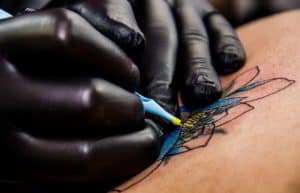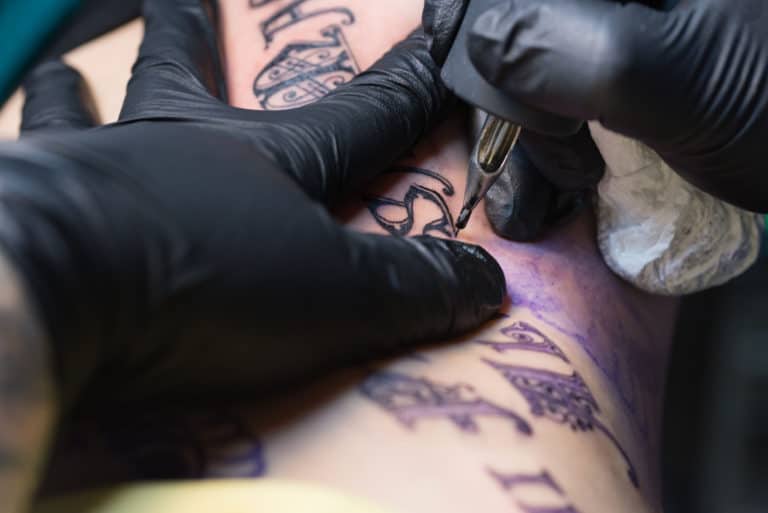Tattoo stencils first came into existence as a tattoo flash, a concept or design that first featured cardboard or paper. Flash artists gave birth to this concept, which is why it graced tattoo parlors in the beginning and still does.
The main idea behind this concept was to have a quick tattooing way, and it earned wide popularity far and wide within no time at all. Flash artists started hand drawing, copying, and distributing their designs to millions of people through the internet, which is how this became a raging trend.
From the biggest tattoo parlors to the smallest ones worldwide, tattoo flash is now a household name. The tattoo stencil relies on an outline sheet, which is the foundation of the stencil.
Although this seems like a very modern trend, tattoo flash has, however, been in existence since the 1930s. Over the years, this process has been through numerous evolutions, and different methods have come into existence for creating stencils.
Today, even those who are not tattoo artists can achieve some incredible looking tattoos on their own, with the user-friendly stencils. You can find access to thousands of websites that offer you a variety of tattoo flash and stencils.
Let’s look into the details of tattoo stencils, their making, and function below.
How Do Tattoo Artists Make Their Own Stencils?
Like we mentioned, two schools of thought have emerged over the years relating to the process of tattoo stencil creation. Both are not complex, but it merely depends on what way works better for a particular artist.

Then there is the other school of thought, which caters to those artists who believe in providing their customers with handmade, qualitative creations.
Tattoos are not cost-friendly: most artists charge exorbitant sums from their customers, but they do create unique, hand-drawn designs. This method gives the artists an opportunity to go through their work and modify and alter the image as they deem fit. It helps them to create and custom their plans to achieve the unique final look they envision for their customer’s skin. If an artist especially values perfectionism, then this method caters to their ideals.
Both methods are not very complex in truth. The only difference, perhaps, is the time they take. While thermofax allows people to complete a tattoo project, the stenciling requires more time and some preparation beforehand too. Perhaps the only complicated part, if we can call it that, for an artist would be the concept drawing part.
Now to make a stencil, an artist has to trace their drawing over the stencil paper. A stencil paper is somewhat similar to carbon paper: the main difference is that it consists of a thin tracing paper that the artist has to place over an inky sheet of paper. Those who opt for a thermofax, resembling a laminator, run the inky sheet through it. The heat from the thermofax helps press the lines onto the stencil paper from the drawing. Thermofax takes significantly less time than hand stenciling.
With thermofax, the artist has to ensure that they use dark ink for the lines on their drawing, not pencil, for the machine to detect them.
Materials to Create Tattoo Stencils
Creating a tattoo stencils does not require complex or extravagant materials. You can make a stencil by hand with the help of tracing paper, a dip pen, a fine-tipped marker, and a stencil fluid. Stenciling requires a dye for transferring the design onto the skin, which is what the stencil fluid is. This dye is not permanent, and you can purchase pens that already have the stencil fluid in them.
How Do They Work?
Stencils work well only when the person using them has prepared the skin well first. If proper prepping of the skin is not done, the stencil will not transfer or stick the image properly. It is important to begin by shaving the hair on the skin area where the tattoo will go.
Next, one must use antibacterial soap for the area where they will apply the stencil and then clean and dry the skin. The last step of prepping includes using a stick deodorant or a stencil lotion on the skin, so the tracing sticks well.
Once the skin is fully ready, you apply the stencil to the area, ensuring the fluid side is right above the skin. Then the person must pat the stencil on the skin and let it for a minute or more to set. It is highly important not to rub the stencil, as this will result in blurring or smudging of the design.
Once you feel the skin has received the imprint well, you can begin peeking the tracing paper away but mind you, do it very carefully. When the paper is off the skin, you must see a neat design in place, all ready for the needle to work its way on the skin.
Are Tattoo Stencils Permanent?
In answer to this question, we need to bring a few facts to your notice. Tattoo stencils are only tracing of the original work you want on your body. The artist traces the designs you want on your skin, and with the help of an alcohol rub, he/she imprints it on your skin.
Once you apply a stencil directly onto your skin, it leaves a permanent outline behind which the artist proceeds to work over with a needle. The reason why stencils are so popular is that it makes the tattooing part onto the skin with the ink, easier for the artists.
When there is a clear outline on the skin from the stencil, all that remains for the artist is to begin inking it away. But till the part where the needle doesn’t begin inking the design on your skin, the stencil print is not permanent.
You can wash it off easily in case you don’t like the design or change your mind about getting the tattoo. However, once the artist puts the needle to your skin and begins tracing the outline, there is no going back, and the tattoo then becomes a permanent mark on your body.
Do all Tattoo Artists Use Stencils?
Tattoo stencils are valuable tools for many artists. This tool enables them to replicate just about any design on their client’s body, from famous pictures on studio walls to custom designs that clients bring in them.
Tracing is a time-honored technique, and there is no doubt how they lend the artistic appeal to the images. This time-honored tradition exists from the time of renaissance masters, who would 
Some of the best artists employ this technique today to create exotic artwork on human skin. With the help of tattoo stencils, most artists are able to ensure they give their clients exactly what they’re asking for.
However, not all artists use tattoo stencils. We even have several famous and lesser-known maestros who go freehand but still do a flawless job. They prefer drawing the images directly on to the skin.
In this approach, some artists create a rough draft first, sealing the design on the skin with the help of a spray after that. Once they have an outline like this, they get to work with a needle thereafter. We also have many freehand artists in the world who employ a vast range of colored markers and steadily build a design.
These permanent markers are not permanent, though. You can wash them off or easily erase them with rubbing alcohol or special soap. Truth be told, we may be inspired by the stencil-using artists, but we’re absolutely awestruck by the freehand geniuses.
They’re the ones who created unique works directly onto the skin, not using any guide or stencil. However, there are chances of some variations in the visibility and positioning of the design, but it is best for clients to use their own discretion in deciding what they want best.
Final Thoughts
Tattoo stencils help artists achieve a mockup of the image the clients want as tattoos on their bodies. Once the clients approve the image they see on their skin, the artists are then able to trace the designs directly on to their skin with a needle. As a client, individuals can work in collaboration with artists and create innovative and unique artwork. Rest assured, tattoos are not only pleasing to the eye but also help some find deep contentment for their souls.

